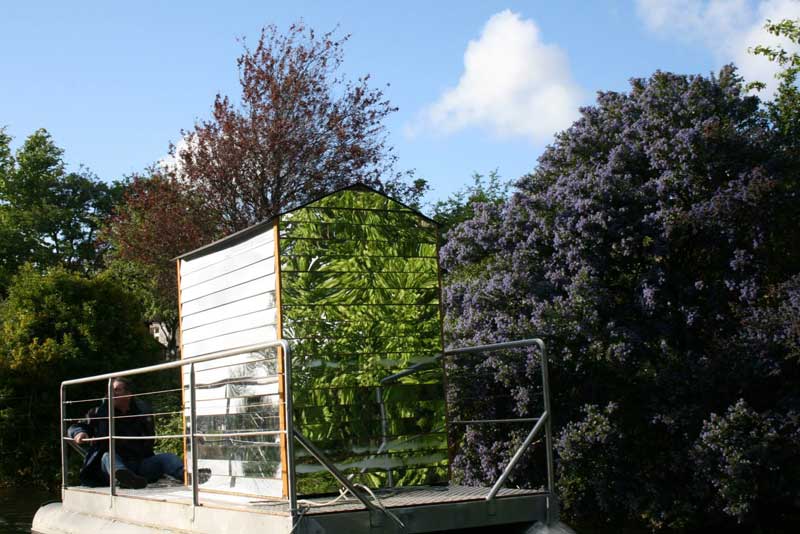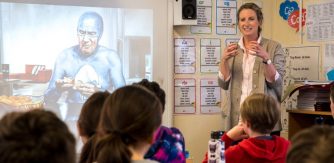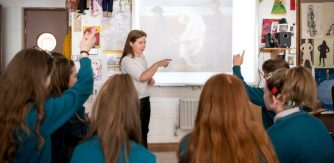Blog 3 – Liz Coman, Assistant Arts Officer Dublin City Council & VTS Facilitator

Artist Kathryn Maguire with artwork by Anita Groener

Liz Coman is an Assistant Arts Officer with Dublin City Council. She is a certified Visual Thinking Strategies facilitator with VTS/USA and has completed training to coaching level. She is responsible for monitoring the quality of Erasmus+ Permission to Wonder – an EU project for Dublin City Council that is testing the VTS training pathway with educators in classroom and gallery settings. Liz has a background in History of Art and Museum Studies and fifteen years experience in designing innovative projects that support arts, education and learning. She has led trainings in enquiry led approaches to mediating artwork for visual art facilitators in The Ark, A Cultural Centre for Children, The National Gallery of Ireland, and The Turner Prize, Derry and offers ongoing mentorship for individual artists, arts educators and teachers.
“We Are Mirrors” – Erasmus+ Permission to Wonder
A Conversation with Visual Artist, Kathryn Maguire
Visual Thinking Strategies is a research based method, founded on the doctoral work of Abigail Housen(Co-Founder of VTS) and her research on aesthetic development. Housen’s research focused on the question – ‘What Happens Cognitively When You Look at a Work of Art?’ Her methodologydevised an ‘Aesthetic Development Interview’ to understand how a spectrum of differentviewers understand and interpret the same artwork. With this data,and drawing on constructivist learning theories, in particular Lev Vygotsky and Jean Piaget, she designed a stage theoryfor aesthetic development. Her stage theory tracked common features of five stages. According to Housen, each stage is inherently important. No stage can be rushed or bypassed. Growth occurs with repeated and regular exposure to viewing art. In her collaboration with Philip Yenawine and MOMA, New York, Housen’sresearch identified that the majority of visitors attending the museum and its programmes were stage 1 & 2 viewers. Stage 1 & 2 viewersjudge an artwork is based on what they know and like, their observations may appear idiosyncratic and imaginative, and they have their own sense of what is realistic and this standard is often applied to determine value. Stage 1&2, as aesthetic learners, are storytellers. Storytelling is a universal means of making meaning. Meaning making requires critical thinking, personal reflection, the consideration of multiple possibilities, communication and respectful debate.
Part of the challenge for me was unlearning earlier teaching practices. I had to…learn a new paradigm, one that put people ahead of art, one that focused on enabling not just engaging people. I had to step back from what I thought people should learn, to create a teaching/learning method that would help them realize their full potential at any given moment. – Philip Yenawine
Professional visual artists, that have trained in Visual Thinking Strategies with us, tell us that VTS can offer them a useful framework to critically appraise their own artwork in development. It is a tool that can inform their understanding of a diversity of interpretations that audiences will bring to the artwork. This can be a valuable input into an artwork’s development before it arrives into the gallery or public space. Visual artists that have trained with us, and been implementing VTS as part of their practice, specifically in schools, report that the neutrality and rigour of the VTS method is their biggest challenge. For me, this is completely understandable. When you love art and have dedicated your life to its study and practice, you want to share all your knowledge and skills with your audience. The visual artists we work with are very generous and committed to sharing with their audiences. However, the time and appropriate support to do this is usually very limited.
Within schools, there may only be one shot – the one class visit to a gallery in a year. Or a school or artist might get support for a suite of sessions or a medium-term residency. Following Housen’s theory, we can propose that more consistent and supported time for art and artists to work with students allows greater opportunity for embedding aesthetic growth and learning. In addition to the time limitation, there are very few training opportunities for artists in understanding pedagogy, curriculum and developmental stages of children and young people according to age, ability and cultural tradition. Therefore, the skill of facilitating meaning making with visual art and children and young people, for many artists, is based on their own process of discovery and how discovery emerges in their practice.
Kathryn Maguire’s practice is inspired by science, history and the social world. She works in the field of socially engaged art, therefore, contrary to making an artwork in isolation, she develops artwork with a community in a way that honours both her areas of inspiration and a community’s vested interest in their neighbourhood. Kathryn has effective collaboration skills that allow space for experts and knowledge from varied backgrounds and sources to inform the development of her work. She is a sculptor, and in particular, specialises in social sculpture. She uses mirrors regularly in her work and understands the value of using mirrors as a reflective tool, that can work equally well in the gallery/museum and also outside, in nature. An example of this is Kathryn’s artwork is ‘Us’ Again – a floating mirrored shed, created in 2013, in collaboration with the Men’s Shed Group based in Rialto’s St Andrew’s Community Centre as part of Maguire’s residency at 468, Common Ground.

Image of ‘Us’ Again -Kathryn Maguire
The shed, made completely of mirrors, journeyed along the Grand Canal, Dublin, to celebrate the impact the waterway has had on labour and leisure in Rialto and as demonstration and reflection on community and commonality. Kathryn’s mirrored shed informs her practice today, as she continues to investigate what is the common between us and our environment.
What do you find VTS brings to your practice as an artist?
As an artist, I feel like an investigative journalist in some ways. I gather knowledge and information and transfer it into an artwork. VTS is a powerful tool for me, as a learner. I’m constantly learning so VTS allows for my knowledge to be fluid. It is really important to me, in my life, and as an artist, that there is more than one answer. Facilitating VTS allows me time to listen to the different ideas coming from each person, to stay neutral, and not buy into one opinion or another. It is really important to stay listening to all the different facets of the conversation. We all come with so much ancestral knowledge. Perhaps allowing time and space for different perspectives, hopefully we can find our way to some common ground. This is what ultimately keeps me motivated – the search for our commonality. It’s why I still work with mirrors – we are mirrors. As an artist, I feel now is an important time. Artists have an incredible opportunity to look more closely, then take that knowledge and make it into an artwork and then take that artwork and go to the audience – it’s a gentle, fluid, domino effect.
What have you noticed happening in your work with schools and galleries in VTS image discussions?
I am currently Artist in Residence with Rathfarnham Educate Together National School (RETNS). I recently did a VTS facilitated discussion the school’s 5th class children at The LAB Gallery and Anita Groener’s incredible exhibition ‘The Past is a Foreign Country’. I observed that the children were highly environmentally aware and were able to articulate very clearly their understanding that if our environment is not harmonious, then that is not good for us either. They mirrored, for me, my own thinking that we are all part of the same ecosystem. This is an emotionally charged exhibition, exploring migration and the migrant crisis in Syria. I didn’t have to tell the children what the work was about. I didn’t have to give them a script. The script was inside them already. It just needed a gentle prise open. VTS allowed us time, and slowing down, deep looking, being comfortable in the silence. There is so much chatter, phone or screen time in our lives that just listening and communicating with each other is an amazing thing. This amazing thing happens when we communicate in a VTS session and I’m still not sure what the ‘thing’ is. This ‘thing’ is what Permission to Wonder has given to me as a person and as an artist.
Can you recall a favourite VTS Image Discussion?
I have been testing the VTS Image Curriculum and the Permission to Wonder images for the project image bank. I have been practicing VTS with test images in Scoil Mhuire, Marino and St Vincents BNS.
Some feedback on the VTS sessions with Kathryn from the 3rd class boys of Scoil Mhuire, Marino, gathered from teacher, Jennifer Gormley
‘It was very enjoyable and I liked that it wasn’t just based on one artist. I liked the way we got asked to say what we thought of the picture.’
‘It was really nice and I liked the way it was arranged, like the questions we were asked.’
‘It was really fun. I liked looking at the pictures and telling what I thought of them.’
‘I thought the paintings were really good and it was fun answering questions.’
Out of this image testing I find that Remedios Varo ‘Creation of the Birds’ 1957 gets a very powerful response, no matter what the age and stage.
Another memorable experience was a Wonder Club session with a Patrick Scott artwork in The Hugh Lane Gallery. The discussion went from a very religious metaphorical discussion into a more polarised religious and political debate. This was surprising as the beautiful abstract painting was a vehicle for adults to vocalise knowledge, and equally prejudices, that the group and I had to negotiate. Perhaps most valuable with adults, you get to access people’s wealth of knowledge due to their lived life.
** Wonder Club is monthly VTS sessions for adults that take place in Dublin City Gallery, The Hugh Lane and The LAB Gallery
How did Erasmus+ Permission to Wonder support you to develop your VTS practice?
I would describe VTS practice like muscle that needs to be exercised. In Permission to Wonder, the trust within the group of educators, and the care within the partner group was really special. There was a silent strength in this support that was very nurturing for me to help me push me out of my comfort zone and become more confident in how I facilitate a VTS session. The logistical supports that were put in place for me were really important. Financial access to the training in Europe and then also being supported to practice at home in the schools and galleries allowed me to build this confidence. On foot of it, opportunities for me to work with galleries and schools have been increasing. In the past year, I’ve been really lucky to work with The LAB Gallery, The Hugh Lane Gallery, IMMA, The Butler Gallery, Kilkenny and all have been very supportive of me using VTS as a strand of my sessions with school groups. I use VTS at the beginning of my sessions almost as a way to bring students into a space where they will absorb the artists’ intentions by osmosis and then the session will evolve from there. I usually do a VTS session, followed by an observational drawing, followed by more formal object making in the education room. I find that the students, when they are sketching after the VTS image discussion, are not copying each other, they are more confident in how their own ideas are coming out of the artwork.
What would you like to work on next in your VTS practice?
The most important thing that I feel I need to work with most is staying neutral. I think that art can bring up a lot of stuff for people, very strong opinions are aired, a lot of debate and also emotional responses. I have to be careful to manage my own assumptions about why somebody might make a particular remark. I have to remember, that it’s okay if a group member does not want to contribute or may pull back or be quiet in the discussion. The strength of the silence may indicate that there may be a reason why somebody remains silent, something may be triggered for that person within the image or the discussion. There is learning in discomfort, but also learning to keep in mind safety and care for the group, and also keep in mind self care for me. I will always talk to a teacher at the outset of a session to find out if I need to be mindful of a member of a group. It’s that communication that needs to happen between us as educators – between teacher and artist – in order that the viewer is allowed to be silent or to be heard, depending on their need.
I would envision that I would like to push my VTS practice further. To move my VTS facilitation outside of art, into other areas such as science, history, mathematics. That I can move it out of the artworld and into other areas of education. I think VTS sits in the artworld but also has the flexibility and ability to move beyond the artworld.


